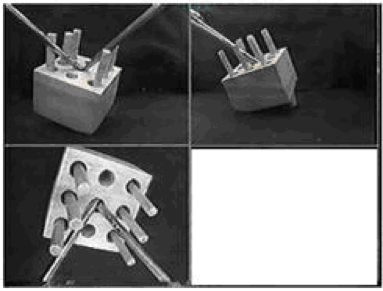Perceptual Factors in Minimally-Invasive Surgery
Your doctor’s ability to perform surgery safely depends on his or her ability to perceive the relative depth between the gall bladder and the surrounding arteries and tissues. The performance of surgery with the use of fiberoptic cameras has brought great benefits to patients, including less injury and faster recovery. However, it makes the job more difficult for surgeons who have to rely on fewer depth cues and a narrower field of view. In short, it is more difficult for the surgeon to move the surgical instruments through the anatomical spaces. Our research aims to apply what we know about depth perception to develop surgical displays. For example, using a surgical simulator, we examined whether three separate views of space—a top view, frontal view, and side view (thus providing more depth information than a single display), would improve perceptual-motor performance (see figure below). Our results show that observers relied upon the top view and did not utilize the other views. In addition, the side view was detrimental to performance. Our most recent work in this area suggests that the multiple displays that surgeons use in the already cluttered operating room can be integrated into one split-screen display without a detrimental effect on performance.

Performance in Nursing
The Institute of Medicine has identified the work environment of nursing as critical in the delivery of safe patient care. Nurses spend the most time with patients compared with all other health care providers. Their performance has a direct impact on the quality of health care that patients receive and thus patient outcomes. The nurse’s critical task is patient surveillance—monitoring changes in the patient’s status to prevent declines in health. However, due to the design of the work environment, nurses spend only about 25% of their time in direct contact with patients. In addition, they engage in multiple tasks at once, shift their attention from one patient to another frequently, and rely heavily on prospective and procedural memory. In short, they have heavy cognitive loads. Yet, they are frequently interrupted which degrades cognitive performance. There is a pressing need to redesign the work environment of nurses to increase efficiency so that they can spend more time with patients. Our research team hopes to contribute to improve the work environment of nurses so that patient safety can be enhanced.
